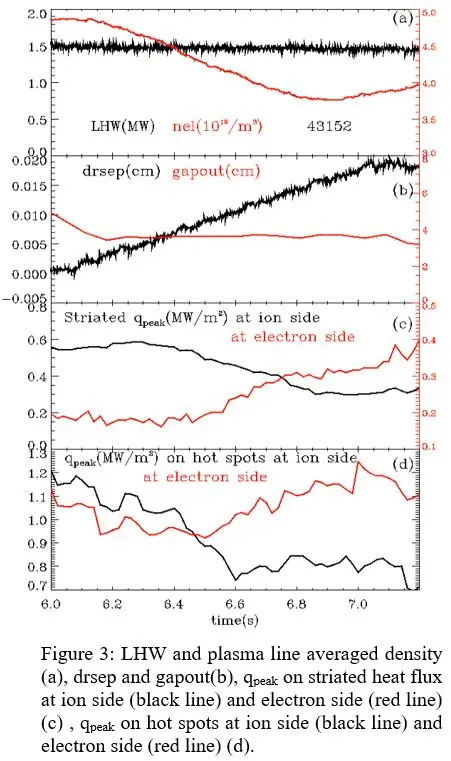Speaker
Description
Lower hybrid waves (LHW) are absorbed in the scrape-off layer (SOL), and then the heated plasma follows the magnetic field lines in the co-current and counter current directions, which intercepts the LHW antenna limiter and divertor plate [1,2]. Hot spots are observed on the guard limiter, and heat flux striations on the divertor plate are observed on both the ion and electron drift sides. In EAST, it was found that a strong electron-ion side asymmetry existed on the striated heat flux. Striated heat flux at the ion side distributed widely in the toroidal direction, while the striated heat flux on the electron side was much weaker and hard to observe at low plasma density. This paper presents the electron-ion side asymmetry on LHW induced striated heat flux, and the divertor geometry affect on striated heat flux in the EAST.
The striated heat flux was found to move to the outer strike point (OSP) during plasma current ramp-up3. Fig. 1 shows the outer divertor heat flux under lower single null (LSN) discharge, with 0.5MA plasma current and ~3.7×1019/m3 plasma current. The OSP is located at R~1.775m, and the striated heat flux peaks at R~1.797m. The peak striated heat flux on the ion side is ~0.65MW/m2, compared to 0.13MW/m2 on the electron side. The heat flux at the lower OSP is larger than at the upper OSP since this was a LSN discharge and most of heat from the main plasma flows to the lower divertor. Note that the heat source for the striated heat flux is from SOL heating generated by LHW absorption in the SOL, not outflux from the main plasma 1. The striated heat flux on the ion side is larger than the heat flux at the OSP, which indicates most of LHW power is deposited in the SOL. Recent experimental results in C-MOD indicated that roughly 80% of the LHW is observed to be promptly deposited in the edge plasma with a parasitic mechanism [4].

Previous results indicated that LHW absorption in the SOL increased with the plasma density and decreased with the outer gap[5]. Here we show that the divertor geometry also significantly affects the LHW absorption in the SOL with stable plasma density and outer gap. The maximum striated q// in Fig. 2(a) represents the qpeak mapped to the outer midplane. The maximum striated q// on the ion side decreased from 11MW/m2 to 6MW/m2 when the drsep changed from -2cm to 2cm (Fig. 2(a)). The plasma density was stable ~2.5×1019/m3 and the outer gap was maintained at ~5cm, while the q// on the hot spots at the ion side decreased by 2.5MW/m2 when drsep changed from -2cm to 0cm. The striated heat flux and hot spots on the electron side were not observed at low plasma density (2.5×1019/m3 ). This indicates the LHW absorption in the SOL was reduced when divertor geometry was changed from LSN to upper single null (USN). The striated q// is ~2cm away from the guard limiter in the midplane, but ~3-5 times larger than the maximum q// at the hot spots. This indicates the LHW absorption in the SOL is stronger when the absorption is closer to the separatrix.

At higher plasma density ~3.5×1019/m3, the striated heat flux appeared at the electron side. Fig. 3 shows an EAST L-mode with Ip=0.4MA and 1.4MW LHW. The striated qpeak at the ion side and qpeak on hot spots at the ion side decreased from double null (DN) to USN, which could be induced by both the decreasing plasma density and changes in divertor geometry. However, the striated qpeak at the electron side increased from 0.2MW/m2 to ~0.3MW/m2 when drsep increased from 0 to 1.5cm, despite the decreasing plasma density from 4.7×1019/m3 to 3.7×1019/m3. Meanwhile, the qpeak on the hot spots at the electron side increase from 0.9 to 1.2MW/m2 when the divertor geometry was changed from DN to USN.
However, the mechanism for the observed ion-electron side asymmetry on the LHW induced striated heat flux is still unknown, e.g. not explicable via Landau damping. Further research is needed for LHW edge loss control and first wall protection.
This work was supported by the US DOE contract DE-SC0016915 and National Natural Science Foundation of China (Grant No. 11775259).
Reference
1 K.F. Gan, et al., Physics of Plasmas 26, 072506 (2019)
2 P. Jacquet, et al., Nucl. Fusion 51 (2011) 103018
3 K.F. Gan, et al., J. Nucl. Mater. 438, S364–S367 (2013)
[4] I. C. Faust, et al., Physics of Plasmas 23, 056115 (2016)
[5] K. M. Rantamaki., et al 2005 Plasma Phys. Control. Fusion 47 1101-8
| Affiliation | university of tennessee,knoxville |
|---|---|
| Country or International Organization | United States |
